Click image for BBB rating
See our Privacy Policy
cool="cool" width="787" height="10196" border="0" cellpadding="0" cellspacing="0" gridx="16" showgridx="showgridx" usegridx="usegridx" gridy="16" showgridy="showgridy" usegridy="usegridy" bgcolor="#99ccff">
|
|
|
 |
|
|
|
|
|
|
|
|
Welcome to Spaightwood Galleries, Inc.
120 Main Street, Upton MA 01568-6193
You can follow us on Facebook at http://www.facebook.com/pages/Spaightwood-Galleries-Inc/122951564441757
I blog there regularly and announce special events and special sales.
|
|
|
|
|
|
|
The Resurrection is the ultimate conclusion to the Passion as a a whole and the event that turns the cowering disciples into the heroic martyrs they will become. For St. Paul, the persecutor of Christians, who was transformed into an Apostle of Christ, risking his life to preach and teach: "the message about the cross is foolishness to those who are perishing, but to us who are being saved it is the power of God. For it is written, 'I will destroy the wisdom of the wise, and the discernment of the discerning I will thwart.' Where is the one who is wise? Where is the scribe? Where is the debater of this age? Has not God made foolish the wisdom of the world? For since, in the wisdom of God, the world did not know God through wisdom, God decided, through the foolishness of our proclamation, to save those who believe. For Jews demand signs and Greeks desire wisdom, but we proclaim Christ crucified, a stumbling block to Jews and foolishness to Gentiles, but to those who are the called, both Jews and Greeks, Christ the power of God and the wisdom of God. For God’s foolishness is wiser than human wisdom, and God’s weakness is stronger than human strength. Consider your own call, brothers and sisters: not many of you were wise by human standards, not many were powerful, not many were of noble birth. But God chose what is foolish in the world to shame the wise; God chose what is weak in the world to shame the strong; God chose what is low and despised in the world, things that are not, to reduce to nothing things that are, so that no one might boast in the presence of God. He is the source of your life in Christ Jesus, who became for us wisdom from God, and righteousness and sanctification and redemption, in order that, as it is written, 'Let the one who boasts, boast in the Lord' " (I Corinthians 1: 18-31). The illogical truth that the Resuurection embodies turned the wise and learned Pharisee that Saul used to be into a fool for Christ: "Do not deceive yourselves. If you think that you are wise in this age, you should become fools so that you may become wise. For the wisdom of this world is foolishness with God. For it is written, 'He catches the wise in their craftiness' " (1 Corinthians 3:18-19). Thanks to Erasmus' Encomium Moriae / The Praise of Folly and, in England, Shakespeare's comedies, especically the ones in which the clowns and fools step forward to show the wise the foolishness of wisdom and the wisdom of folly (an explicit theme in A Midsummer NIght's Dream, As You Like It, and Twelfth Night)." But the wisdom of what St. Paul calls the Folly of the Cross is for him the ultimate truth to which all Christians must witness: "Now if Christ is proclaimed as raised from the dead, how can some of you say there is no resurrection of the dead? If there is no resurrection of the dead, then Christ has not been raised; and if Christ has not been raised, then our proclamation has been in vain and your faith has been in vain. We are even found to be misrepresenting God, because we testified of God that he raised Christ—whom he did not raise if it is true that the dead are not raised. For if the dead are not raised, then Christ has not been raised. Christ has not been raised, your faith is futile and you are still in your sins. Then those also who have died in Christ have perished. If for this life only we have hoped in Christ, we are of all people most to be pitied. But in fact Christ has been raised from the dead, the first fruits of those who have died. For since death came through a human being, the resurrection of the dead has also come through a human being; for as all die in Adam, so all will be made alive in Christ." (I Corinthians 15:12-22).
|
|
|
|
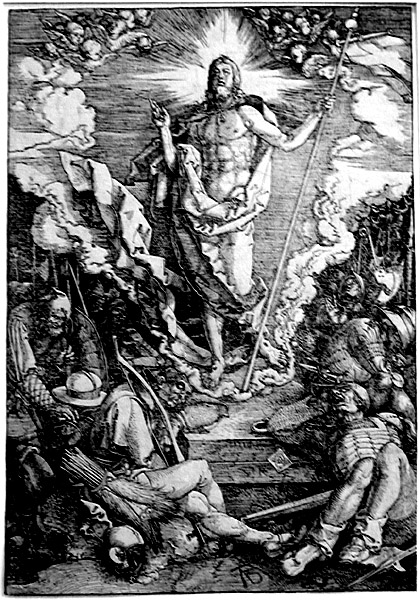 |
|
|
|
|
Albrecht Durer (Nuremburg, 1471-1528), The Resurrection (B. 15, S. 151, M. 124). Original woodcut, 1510. From the 1511 Latin edition of the Large Woodcut Passion, the first edition of the complete Large Woodcut Passion. Dated 1510 and signed in the block. Trimmed to the border. Panofsky says, "We have the impression that a magic carpet is lowered so as to invade our field of vision and to transfuse rather than overthrow the natural world." Image size: 390x270mm. Price: SOLD.
|
|
|
|
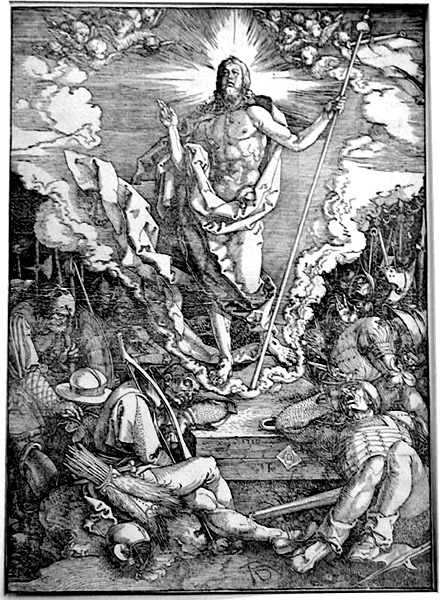 |
|
Albrecht Durer (Nuremburg, 1471-1528), The Resurrection (B. 15, S. 151, M. 124). Original woodcut, 1510. A fair Meder b impression after the 1511 Latin text edition trimmed on or just outside the margins. Panofsky says, "We have the impression that a magic carpet is lowered so as to invade our field of vision and to transfuse rather than overthrow the natural world." In the 15th century, Jesus is normally shown standing rather firmly on the lid of the stone; here, as Panofsky notes, he is shown in an indeterminate space neither solidly on the earth nor yet completely transcendant (as in Durer's Transfiguration, where he floats above the earth). One of the most important visionary prints of the Renaissance. Wormhole in Christ's abdomen, backed with thin laid paper. Image size: 390x279mm. Price: Please call or email for current pricing information.
Condition: long vertical crease going through Christ's left elbow; horizontal creases through Christ's knees; wormhole in Christ's abdomen; small stain in second from bottom right gurd's armpit; small stain in quiver of lower left guard; backed with thin laid paper.
|
|
|
|
|
|
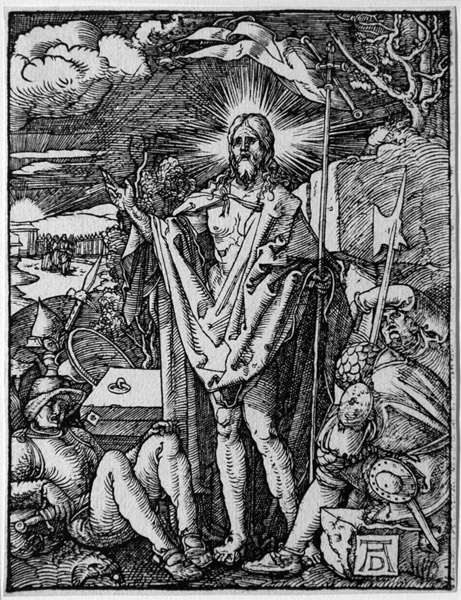 |
|
|
Albrecht Durer (Nuremburg, 1471-1528), The Resurrection (B. 45, S. 129) Original woodcut, c. 1510 for the Small Passion. A rich early impression after the first published edition of 1511 (no text on verso). The scene follows Matthew rather than the accounts in Mark, Luke, or John: "After the sabbath, as the first day of the week was dawning, Mary Magdalene and the other Mary went to see the tomb. And suddenly there was a great earthquake; for an angel of the Lord, descending from heaven, came and rolled back the stone and sat on it. His appearance was like lightning, and his clothing white as snow. For fear of him the guards shook and became like dead men. But the angel said to the women, 'Do not be afraid; I know that you are looking for Jesus who was crucified. He is not here; for he has been raised, as he said. Come, see the place where he lay. Then go quickly and tell his disciples, He has been raised from the dead, and indeed he is going ahead of you to Galilee; there you will see him. This is my message for you.' So they left the tomb quickly with fear and great joy, and ran to tell his disciples. Suddenly Jesus met them and said, 'Greetings!' And they came to him, took hold of his feet, and worshiped him. Then Jesus said to them, 'Do not be afraid; go and tell my brothers to go to Galilee; there they will see me.' " The block prints darkly and there are no breaks in the borders. A very fine impression trimmed just outside the borders. Image size: 126x96mm. Price: Please call or email for current pricing information.
|
|
|
|
|
|
|
|
|
|
|
|
|
 |
|
Albrecht Durer (Nuremburg, 1471-1528), The Resurrection (B. 45, S. 129) Original woodcut, c. 1510 for the Small Passion. In 1844 plaster casts were made from Durer's original woodblocks for the Small Woodcut Passion, which had just been acquired by the British Museum. From these casts, metal plates were made and a small edition produced. Our impression is from this edition. Image size: 125x95mm. Price: Please call or email for current pricing information.
|
|
|
|
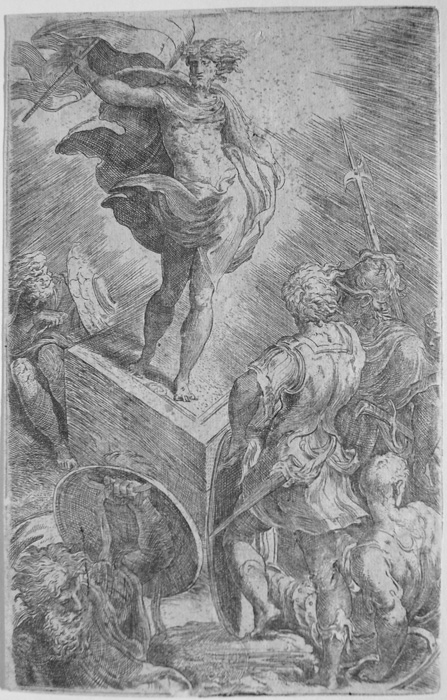 |
|
Parmigianino, The Reurrection (Bartsch 6). Original etching, c. 1527-30. A very good impression on laid paper. According to David Ekserdjian's essay on Parmigianino's drawings and prints, Parmigianino is the "de facto father of Italian etching" (Ekserdjian, in Franklin, p. 42). Thread margins. There is a full-page reproducion of this engraving in The Renaissance Engravers, ed. Charmian Mezentseva, Curator of the Northern European Prints at the Hermitage Museum in Petersburg, Russia, all of whose examples are drawn from the print collection of the Hermitage Museum; ours appears to be a stronger impression. Parmigianino was one of the most important of the first generation of Italian Mannerists. He influenced several generations of successors. Rare! One might also describe it as "Extremely scarce" another description, but we try to avoid hyperbole (except when we revel in it!). Image size: 213x136mm. Price: Please call or email for current pricing information.
Despite appearances, the print is rectangular; the photograph was slightly off-plane resuting in the trapezoidal shape.
|
|
|
|
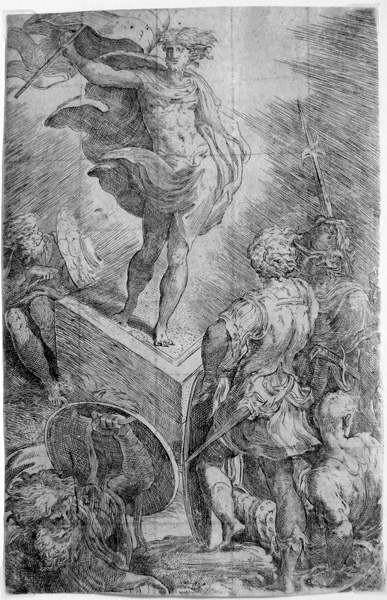 |
|
Parmigianino, The Reurrection (Bartsch 6). Original etching, c. 1527-30. A rich, dark impression on laid paper. According to David Ekserdjian's essay on Parmigianino's drawings and prints, Parmigianino is the "de facto father of Italian etching" (Ekserdjian, in Franklin, p. 42). Trimmed inside the plate mark; squared for transfer to a canvas. There is a full-page reproduction of this engraving in The Renaissance Engravers, ed. Charmian Mezentseva, Curator of the Northern European Prints at the Hermitage Museum in Petersburg, Russia, all of whose examples are drawn from the print collection of the Hermitage Museum. Although it is hard to judge from the photograph, ours appears to be a stronger impression. Parmigianino was one of the most important of the first generation of Italian Mannerists. He influenced several generations of successors. Rare! Image size: 211x136mm; our impression as trimmed: 209x132mm. Price: Please call or email for current pricing information.
Despite appearances, the print is rectangular; the photograph was slightly off-plane resuting in the trapezoidal shape.
|
|
|
|
|
|
|
|
|
|
 |
|
Diana Scultori (Mantua, before 1542-1612, Rome) The Resurrection (B. 10, Albricci 35), engraving after Giulio Romano. This is a reverse copy of her father's engraving (Bartsch 5). Inscribed lower right: "Iulius Mantuanus inv." Numbered "38" in pen just below the top right. Trimmed on or within the platemark; the diagonal cuts at the two top corners are as designed. Image size: 235x168mm. Price: Please call or email for current pricing information.
|
|
|
|
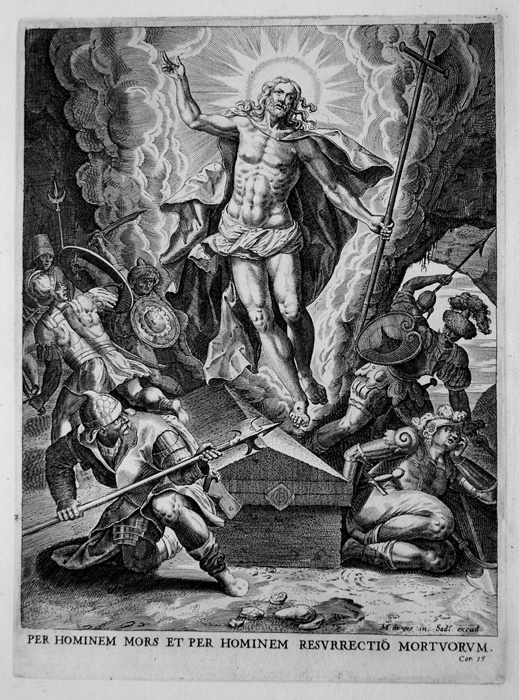 |
|
|
Jan Sadeler (Flemish, 1550-1600), The Resurrection (New Hollstein de Vos 417 i, TIB 7004: 103). Engraving after a lost drawing by Maarten de Vos, 1579-1582. A very good impression on laid paper of the first state with large margins. Executed for The Mysteries of the Rosary. Signed lower right: "MdeVos in / Sadl. excud." Isabelle de Ramaix (in TIB 7004, p. 123) says "They are likely to have been engraved by Johan I and Raphael I Sadeler under Johan I's supervision." Image size: 195x147mm. Price: Please call or email for current pricing information.
|
|
|
|
|
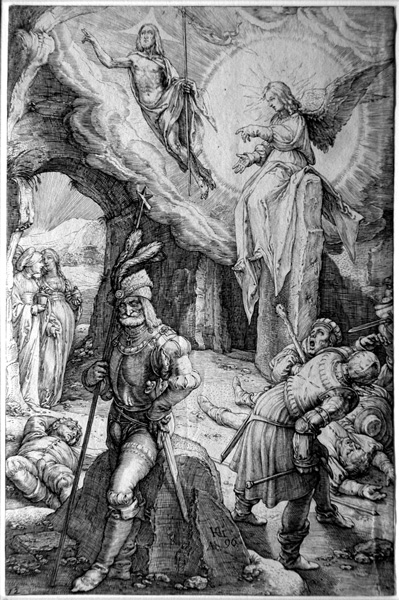 |
|
|
Hendrik Goltzius (Dutch, 1558-1617), The Resurrection (Bartsch 38, Hirschmann 32, Strauss 333 i/ii). Original engraving, 1596. A beautiful impression on laid paper of the first state of two, trimmed on or within the platemark. Signed, dated, and numbered 12 in the plate. Watermark: Coat of Basel with three rings attached (Briquet 1314, 1591). Strauss says Goltzius here departs radically from both Durer and Lucas van Leyden here by having Christ ascending diagonally in the picture plane, unobserved by bystanders (except for the two guards lower right, one of whom stares open-mouthed while the other tries to shield himself from the explosion of light). Ex collection John S. Philips, The Pennsylvania Academy of Fine Arts (with their P.A.F.A. stamp verso), and the Philadelphia Museum of Art, who received it as part of their purchase of the PAFA collection and offered it for sale as surplus. Thread margins on all sides. Image size: 198x130mm. Price: Please call or email for current pricing information.
|
|
|
|
|
|
|
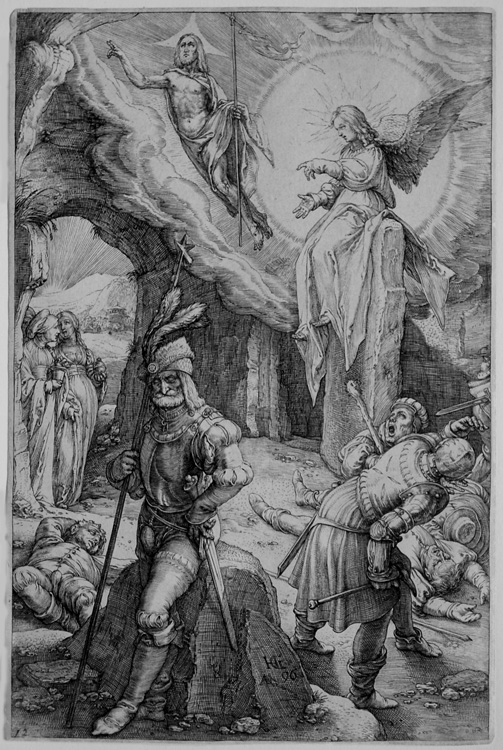 |
|
Hendrik Goltzius (Dutch, 1558-1617), The Resurrection (Bartsch 38, Hirschmann 32, Strauss 333 i/ii). Original engraving, 1596. A very good subtle impression on laid paper of the first state of two, trimmed on or within the platemark. Signed, dated, and numbered 12 in the plate. Watermark: Coat of Basel with three rings attached surmounted by a tower (similar to Briquet 1314, 1591). Strauss says Goltzius here departs radically from both Durer and Lucas van Leyden here by having Christ ascending diagonally in the picture plane, unobserved by bystanders (except for the two guards lower right, one of whom stares open-mouthed while the other tries to shield himself from the explosion of light). Ex collection Philadelphia Museum of Art, with their acquisition nuber in pencil crossed out and offered it for sale as surplus. Trimmed within the platemark but outside the border on all sides. Image size: 197x132mm. Price: Please call or email for current pricing information.
|
|
|
|
|
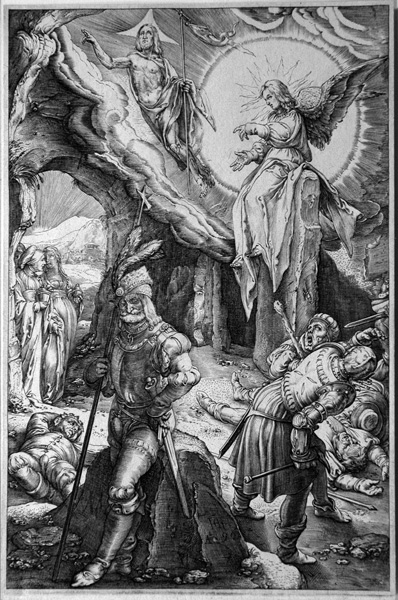 |
|
Hendrik Goltzius (Dutch, 1558-1617), The Resurrection (Bartsch 38, Hirschmann 32, Strauss 333 i/ii). Engraving after Goltzius, 1596. Strauss calls this a "deceptive copy, but lacking the numeral 12" lower left. A beautiful impression on laid paper. Signed HG and dated 96 in the plate. Thread margins on all sides. Image size: 195x128mm. Price: Please call or email for current pricing information.
|
|
|
|
|
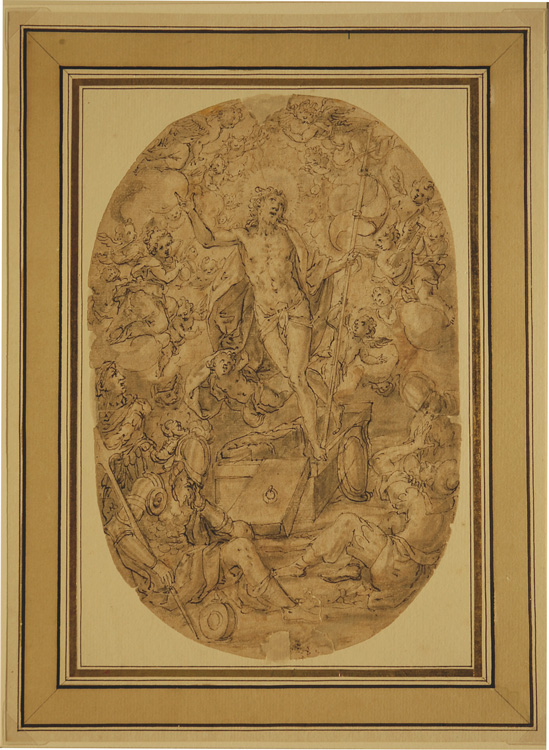 |
Hans van Aachen (Cologne 1552-1615 Prague), attributed, The Resurrection. Pen and brown ink and wash on cream laid paper. In the Grove Dictionary of Art (Oxford: Oxford University Press, 1996, Rigmor Lovring introduces him as "One of the foremost painters of the circle gathered at the Prague Court of Emperor Rudolf II" and adds that he synthesized Italian and Netherlandish influences in his portraits and allegories" (I: 5). Between 1587 and 1592, he was based in Munich, where he had contact with figures such as Friedrich Sustris, Peter Candid, and Christoph Schwartz, as well as the engravers Jan and Raphael Sadeler." In 1592, the Emperor apponted Hans a court painter who need not be present at court, and soon set him to work painting pictures for the court, as well as trips abroad to various courts in German cities, Innsbruck, Venice, Turin, Mantua, and Modena, both as Rudolf II's art agent, but also as a "diplomat and envoy of the Emperor." He was knighted by Rudolf II and, after Rudolf's death, his positions were confirmed by his brother, the Emperor Matthias, and given an estate. Hans, Bartholomäis Spranger, and Joseph Heintz, were the "main representatives of the late Mannerist, internationally-influenced style of art at the court of Rudolf II in Prague. . . . [Hans's] works veer between an idealized style of painting indebted to Roman and Florentime Mannerism as well as to Venetian models (Titian, Veronese, Tintoretto) and the newly emerging tradition Dutch realism." (I: 6). Image size: 222x145mm. Price: Please call or email for current pricing information.
|
|
|
|
|
|
|
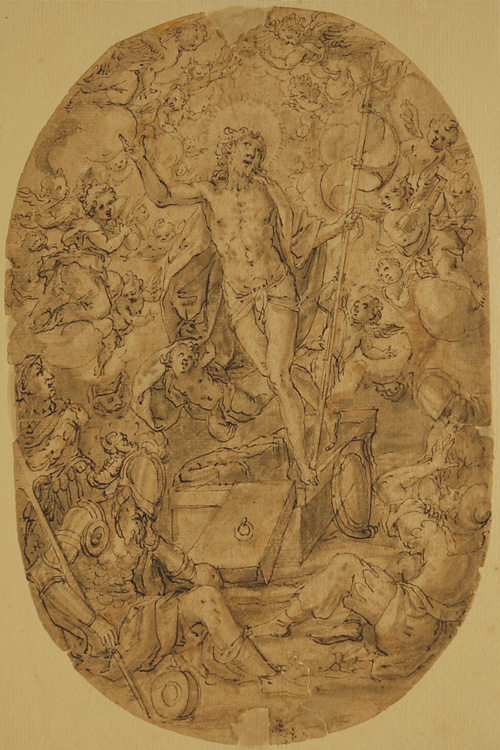 |
|
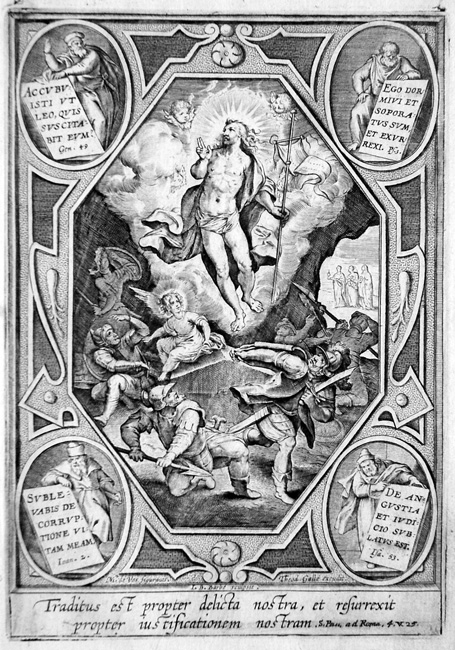 |
|
|
|
|
Jean Baptiste Barbe (Antwerp, 1578-1649). The Resurrection (Hollstein 41-44). One of a set of 12 on sin and its expiation. Published by Theodore Galle (c. 1570-1633). Engraving after Maarten de Vos. Christ has risen from his tomb, holding the banner of salvation, moving from the darkness of the tomb into a divine space whose height is defined by two cherubim top left and right. The guards are attempting to come into a defensive position with swords, shields, and spears at ready, but seem unable to do so. Meanwhile, upper right, three of the holy women are walking toward the tomb to prepare the body for burial, but all they will encounter there is the angel sitting on the edge of the tomb, waiting to give them their instructions. A good sharp impression with margins outside the platemark. Barbe was active in Antwerp during the late 16th and early 17th-centuries. He was a pupil of Philips Galle. He became a Master in 1610 and engraved works after Rubens, de Vos and others. Image size: 160x112mm. Price: Please call or email for current pricing information.
|
|
|
|
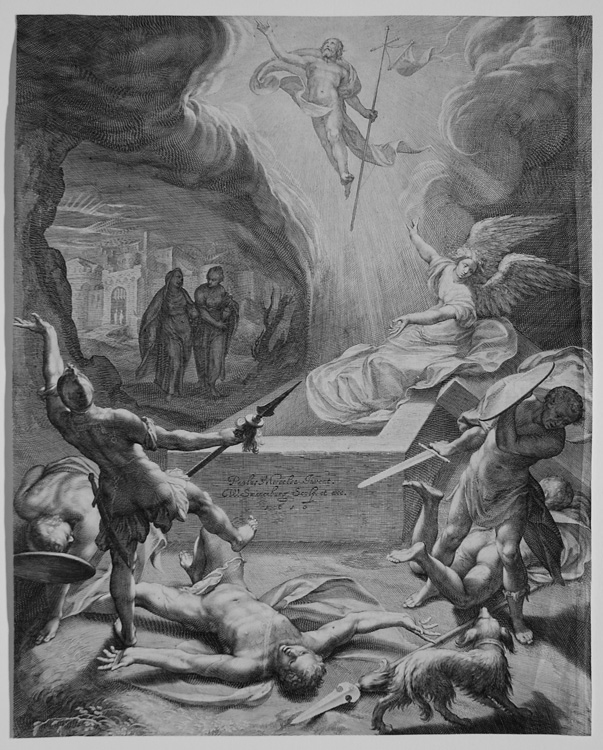 |
|
Willem van Swanenburg (Leiden, 1580-1612). The Resurrection (Hollstein 5 i/ii). Engraving after Paulus Moreleese, 1610. Van Swanenburg presents one of the most defined represntations of the Resurrection, here settled into its new Netherlandish and German style: Christ has once again erupted from his tomb, holding the banner of salvation, moving from the darkness below to the light of the sun. The guards are trying to shield themselves from the light without success: one of them is hiding behind his shield at right; one is on his knees, hiding behind his shield, andd turning his back to the light. One has been blasted down to the ground by the force of Jesus' resurrection, and one is about to fall, staggering off balance, spear in hand. Meanwhile, upper left, two of the holy women are walking toward the tomb to prepare the body for burial, but all they will find there is an angel sitting on the edge of the tomb, waiting to give them their instructions. In the Grove Dictionary of Art (Oxford: Oxford University Press, 1996), 30: 60, Rudolf Ekkart describes Willem van Swanenburg as "one of the best young Dutch engravers of the early 17th century. His work includes prints after Joachim Wtewael, Abraham Bloemaert, and Peter-Paul Rubens." Image size: 381x305mm. Price: Please call or email for current pricing information.
|
|
|
|
|
Spaightwood Galleries, Inc.
To purchase, call us at 1-800-809-3343 (1-508-529-2511 in Upton MA & vicinity) or send an email to spaightwood@gmail.com.
We accept AmericanExpress, DiscoverCard, MasterCard, and Visa.
We also accept wire transfers and paypal.
For directions and visiting information, please call. We are, of course, always available over the web and by telephone (see above for contact information). Click the following for links to past shows and artists. For a visual tour of the gallery, please click here. For information about Andy Weiner and Sonja Hansard-Weiner, please click here. For a list of special offers currently available, see Specials.
All works are sold with an unconditional guarantee of authenticity (as described in our website listing).
Go back to the top of this page.
Visiting hours: Saturday 10:00 am to 5:00 pm and Sunday noon to 6:00 pm and other times by arrangement.
Please call to confirm your visit. Browsers and guests are welcome.
|
|
|
|
|
|
|
|
|
|
|
|
|
|
|
|
|
|
|
|
|
|
|
|
|
|
|
|
|
|
|
|
|
|
|
|
|
|
|
|
|
|
|
|
|














